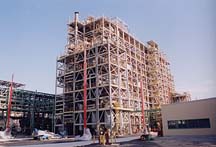
This is significant. R-125 is the largest single component of such HFC refrigerant blends as R-410A, -407C, -404A, and -507, the key refrigerants for the future of residential and commercial air conditioning and refrigeration in a world without CFCs or HCFCs.
A ribbon-cutting ceremony marked the initiation of R-125 production here. According to Richard Preziotti, vice president and general manager of Honeywell Chemicals, “We are committed to being the premier manufacturer and supplier of non-ozone-depleting refrigerants for equipment manufacturers and service channels around the world. “This new facility clearly demonstrates our commitment to our customers.”
Honeywell broke ground on the facility in 2001 and eventually invested more than $100 million to design and construct the plant, with an eight-story-tall, modular gridwork framing a vast array of production components.
Honeywell makes R-125 available to other refrigerant manufacturers, as well as for use in its own brands — Genetron® in North America, South America, and Asia, and Honeywell® in Europe and the Middle East.
According to the company, a ramp up to full production is expected during the first quarter of 2003. In addition to HFC-125, the Geismar plant also produces hydrofluoric acid used in a number of fluorocarbon products, and the refrigerant 245fa, which was developed to replace HCFC-141b, a refrigerant used in foam blowing agents that was one of the first HCFCs to be totally phased out.

Best Location
“Geismar was the best place to locate this new facility for several reasons,” said Preziotti. “First, we already had our multi-products plant on the site where we manufacture a variety of HFC and HCFC products, giving us an experienced workforce and a proven supply chain.“Second, the new HFC-125 plant was constructed in tandem with our HFC-245fa facility, which produces Enovate 3000, the leading HFC replacement for HCFC-141b.
“By constructing both plants at one time,” Preziotti said, “we reduced our overall plant construction costs; although together they represent an investment in excess of $200 million in new HFC capacity.”
The complex is located on a former sugar cane plantation along the shores of the Mississippi River, about 15 miles south of Baton Rouge.
In the most basic terms, the creation of R-125 involves the use of the raw materials perchloroethylene and hydrofluoric acid, which are reacted together. Extensive vertical piping allows for distillation. Guiding the complex process is a sophisticated process computer control system, also from Honeywell.

The Construction
According to Dave Cope, Geismar site leader, the construction project took about 18 months, which included the fabrication in Texas of 44 modular towers (each 14 feet by 14 feet), which were then shipped to the Geismar site and interlocked into the eight-story structure.The site has approximately 40 miles of piping, 200 miles of wiring and cable, 500 major pieces of equipment, and 4,000 instruments.
Cope added, “The land here is great for growing crops but not for building on.” Because of that, the placing of 3,300 pilings preceded the erection of the production facility.
“This was a complex project. We all did things we had never done before.”
He said the plant operates 24 hours a day, seven days a week, 365 days a year. There are 285 Honeywell employees on site, with an additional 115 contract employees involved in maintenance and temporary office support.
Employees work 12-hour shifts alternating between three- and four-day workweeks. The nonunion plant consists entirely of salaried employees, Cope said.
Business Strategy
Honeywell’s fluorocarbon business is one part of a four-pronged company that includes aerospace, which is 41 percent of Honeywell’s overall business, the largest of the four sectors; transportation, which includes such brand names as Fram, Autolite, Prestone, and Bendix; and automation and controls, which includes the familiar Honeywell thermostats.The fluorocarbon business is part of Honeywell’s Specialty Materials sector that includes 12,000 employees in 17 countries, according to Preziotti.
In 1999, Honeywell got into the refrigerant market by means of AlliedSignal, which already offered its Genetron product line and the new combined company changed its name to Honeywell.
Allied first became involved in refrigerants in the 1940s on a regional basis in the United States. By the 1980s, the company served all of North America and was active in the development of alternatives refrigerants first to CFCs, and then to HCFCs. By the 1990s, the company had a global presence.
Publication date: 05/26/2003


Report Abusive Comment